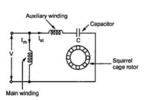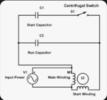- Joined
- 22 Apr 2024
- Messages
- 6
- Reaction score
- 0
- Country

My Vortice extractor fan has stopped working and I'm trying to determine if the problem is the timer/controller circuit or the motor. I thought the easiest place to start would be to prove whether the motor works if I wire it up directly on the bench but I can't find any documentation about how I should connect it. It has five wires (red, blue, grey, black, white). I do know the black and white are for the high and low speed (it's a 2-speed motor). I can't find a spec sheet for the motor anywhere. It's one of these motors if that helps.
I don't really know much about ac induction motors so can anybody suggest how I should wire it up to test it? Or even just how to determine which wires are for what purpose with a multimeter. I've opened the case up and can't see any visible broken or burnt wire and the motor spins freely on its bearings.
I don't really know much about ac induction motors so can anybody suggest how I should wire it up to test it? Or even just how to determine which wires are for what purpose with a multimeter. I've opened the case up and can't see any visible broken or burnt wire and the motor spins freely on its bearings.



